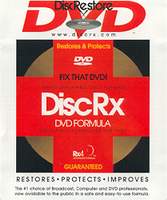
This review is sponsored by

This review is sponsored by
 |
A common problem that has emerged since the very dawn of the CD Digital Audio format is the inherently difficult nature of caring for one's discs, as well as repairing discs that have been damaged in some way, be it by accidental mishandling, or because of persons less careful than yourself getting their hands on a disc. For years, various products have been marketed as being able to repair certain kinds of damage to our beloved shiny discs, so it is only fitting that there be a product marketed as being tailored for the DVD format. The packaging makes many bold claims along the lines of making unplayable discs playable again. Although I have yet to become the proud owner of a DVD that has become unplayable, there has been many an occasion where one of my CD-DA discs has either refused to play or stubbornly decided to skip at a certain time. According to the packaging, Disc Restore was invented in Silicon Valley ten years ago, during which time it has been used by professionals the world over, and is now available to the general public. Given that the general public in question would never admit that the problems they might have with small, shiny discs could be related to their own way of handling them (you wouldn't believe some of the stories I could tell), such a product as this would be in hot demand. So, with some cynicism and foreboding, I decided to put this cleaning and restoring product through its paces.
After cleaning this particular disc, I played it in a variety of CD players to test if there was any discernible difference in performance after the cleaning. Neither of the CD drives in my computer picked up on any problem with the disc, which is no surprise considering that they are rated at thirty and thirty-two times the standard reading speed of CD anyway. My standalone Sony CDP-XE300 also stated that all was well with the disc, which is something of a surprise given that Sony CD players have long had a reputation as being more intolerant to imperfections in the material they are trying to read. A pleasant surprise, however, was that the disc played back without missing a beat on the portable stereo that most often found problems with the scuff marks, a Sanyo MCD-S810F. Given that this player is nearly a decade old and has often spat the dummy at discs for merely having a hair stuck to them, this was an encouraging sign. However, one must take note that if the CD looks scuffed and marked when examined under the light, Disc Restore will not make the marks disappear altogether in spite of how well it seems to improve the disc's playability.
The next test for this product I performed was one of how well the cleaning agent performed by itself on a disc that was marked by fingerprints. To this end, I used the El Mariachi/Desperado double-featured DVD, one of the few discs that I can tolerate being dual-sided in spite of how damned hard these discs are to take care of. The data surface on both sides of this disc had noticeable fingerprint marks upon them (oil from certain parts of your hand tends to "bleed" into discs no matter how you hold them in my experience), so I merely used the Care formula to clean both sides of this DVD. The Care formula tends to wipe off the disc quite easily after a few minutes of effort, taking any fingerprints and dust with it, whereas the Repair formula did leave behind some streaking in spite of concentrated effort to wipe it away. Given that the Repair formula is meant to be used in conjunction with the Care formula, I don't believe this will be much of a problem for most users. Funnily enough, after cleaning the disc with the Care formula and the white "opticloth", the disc seemed to respond more quickly to my remote inputs, although whether this was just a perception or a real difference is something I cannot comment on with any authority.
As far as the concerns about making the disc in question any worse are concerned, I found that such fears on my part were completely unjustified. Naturally, I used the product more or less exactly as specified in the instructions, but the point is that after cleaning a disc that had presented some difficulties beforehand, there seemed to be some noticeable improvement. In that regard, this product delivers pleasing results that are consistent with the manufacturer's claims.
© Dean McIntosh (my bio
sucks... read it anyway)
June 17, 2000